|
|
|
|
|
|
|
|
|
|
|
|
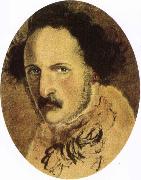 |
mikhail glinka
|
|
Period: Romantic (1820-1869)
Country: Russia
Born: June 01, 1804 in Novospasskoye, Smolensk, Russia
Died: February 15, 1857 in Berlin, Germany
Genres: Chamber Music, Keyboard Music, Miscellaneous Music, Opera, Orchestral Music, Vocal Music
|
|
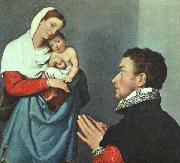 |
MORONI, Giovanni Battista
|
|
Italian Mannerist Painter, ca.1520-1578
.Italian painter. He was the most significant painter of the 16th-century school of Bergamo and is best known for his portraits, which feature a naturalistic rendering of both faces and costume and an objective approach to character. |
|
|
|
|
|
|
|
|
|
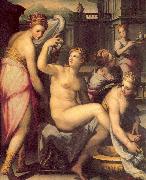 |
Naldini, Giovanni Battista
|
|
Italian, 1537-91
was an Italian painter of a late-Mannerism in Florence. His first apprenticeship (1549-57) was in the studio of Jacopo Pontormo. He went from Rome for a number of months following 1560, and was recruited to work for Giorgio Vasari in 1562. He painted two crowded, mannerist canvas for the Studiolo of Francesco I in the Palazzo Vecchio: the Allegory of Dreams and the Gathering of Ambergris. He supplied altarpieces to Santa Maria Novella and Santa Croce. He painted an altarpiece of Calling of Saint Matthew for the Salviati Chapel in San Marco, where he worked alongside Francesco Morandini. Ultimately, he is aptly described by Freedberg as displaying work distantly derivative from the style of Andrea del Sarto, as expressed by Naldini's two mentors and Sarto's two pupils: Pontormo and Vasari. |
|
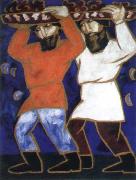 |
natalia goncharova
|
|
natalia goncharova(1881 to 1962),Russian painter, stage designer, printmaker and illustrator. She was a leading artist of the Russian avant-garde in the early 20th century but became a celebrity in the West through her work for SERGE DIAGHILEV and the BALLETS RUSSES. During the 1920s she played a significant role within the Ecole de Paris and continued to live and work in France until her death.
|
|
|
|
|
|
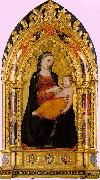 |
Niccolo di Pietro Gerini
|
|
Italian Painter, active ca.1368-1415
died in Florence in 1415, earned reputation of an important Italian painter. He represents giottesque school, in the tradition of the Andrea di Orcagna (1320-1368) and of Taddeo Gaddi. His father Pietro Geri is registered as a member of Lucas Guild in 1339. Niccolo worked mainly in Florence, although he also carried out commissions in Rome (Vatican), Pisa and Prato.
He was first recorded in 1368 as a member of the Arte dei Medici e Speziali in Florence but is identifiable with the Niccolo dipintore who collaborated with Jacopo di Cione on frescoes for the Guildhall of the Judges and Notaries in Florence in 1366. It is self-evident that he is the Niccolaio dipintore who worked with Jacopo di Cione on the altarpiece of the Coronation of the Virgin (presently in London, National Gallery) for St Pier Maggiore, Florence in 1370 and was paid 12 golden florins per disegnare la tavola dell altare in November of the same year. He designed the altarpiece and the elaborate throne canopy with his usual fine painting and detailed ornaments whilst Jacopo di Cione was depicting side saints. This altarpiece is amongst of very few largest commissioned in 14th century Florence. It was seemingly commissioned by Albizzi family.
He was collaborating with Jacopo di Cione on Coronation of the Virgin (Accademia, Florence) in 1372. Offner and Steinweg suggest that he was responsible for the design and fine painting and Jacopo for the execution of saints. It was commissioned by the mint of Florence Zecca Vecchia on the same year.
In 1383 Gerini again worked with Cione on a fresco of the Annunciation in the Palazzo dei Priori, Volterra. This fresco clearly shows the work of two very different artists: Niccolo di Pietro Gerini (design and very fine painting) and Jacopo di Cione (broadly painted saints and side decoration). In 1386 Niccolo frescoed the façade of the Bigallo, Florence. He also frescoed Sant Ambrogio church in Florence
Gerini performed the Crocefissione of St Felicita church in Florence.
His hand is clearly on sacrestia of the basilica of Saint Croce to Florence with Scenes of the life of Christ. Between 1391 and 1392 he worked in Prato where he frescoed Palazzo Datini, church of Saint Francisco with Lorenzo di Niccolo and Agnolo Gaddi.
He also frescoed capitolare of the church of Saint Francisco, Pisa.
Very typically for Gothic depiction Gerini figures have large chins, sloping foreheads, and sharp noses whilst their bodies are squat and frontally displaced.
Another important artist Lorenzo di Niccol?? di Martino was trained in Niccol?? di Pietro Gerini workshop and later collaborated with the master but was not his son as sometimes erroneously stated. Gerini though had a son Bindo di Niccolo di Pietro Gerini, born in 1363, who is registered as member of Lucas Guild since 1408.
Niccolo di Pietro Gerini works can be found in major art galleries of Rome, Vatican, Florence, London, Milan, New York, Los Angeles, Amsterdam, Berlin, Paris, St Petersburg, Boston, Cambridge, Budapest, Birmingham, Pegalo, Prato, Pisa, Altenburg, Avignon, Denver and several other museums. |
|
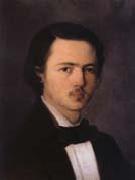 |
Nicolae Grigorescu
|
|
Romanian Painter, 1838-1907
From 1848 he trained in Bucharest with various church painters, producing icons and religious mural decorations. These works, which soon attracted attention, were influenced in style by the Viennese classicism widespread in the Romanian principalities in the early 19th century and by the Italian academicism established there after 1850 by Gheorghe Tattarescu. The earliest of his known paintings are in the church of SS Constantin and Elena at Baicoi, where his signature can be seen beside that of Nita Pereescu on the icon of St George (1853). He subsequently painted a series of icons (1854-5) at Caldarusani Monastery. In the later ensembles he was assisted by his older brother Georghe Grigorescu, who participated under his direction in the decoration of churches, such as those of the Zamfira (1856-8) and Agapia (1858-60) monasteries. In Nicolae's paintings at Agapia, classicism in Romanian art reached its highest point. The royal icons are distinguished for the elegance of the figures, both in their attitudes and in their drapery. |
|
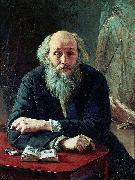 |
Nikolai Ge
|
|
1831 C 13 June [O.S. 1 June] 1894) was a Russian realist painter famous for his works on historical and religious motifs.
Nikolai Ge was born in Voronezh to a Russian noble family of French origin. His grandfather emigrated to Russia in the 18th century. His parents died when he was still a child, so Nikolai was raised by his serf nurse. He graduated from the First Kiev Gymnasium and studied at the physics-mathematics department of Kiev University and Saint Petersburg University.
In 1850 he gave up his career in science and entered the Imperial Academy of Arts in Saint Petersburg. He studied in academy under the historical painter Pyotr Basin until 1857. He graduated from the academy in 1857 with a gold medal for his painting The Witch of Endor Calling Up the Spirit of the Prophet Samuel. According to Ge himself, during that period he was strongly influenced by Karl Brullov.
His gold medal provided him a scholarship for studying abroad . He visited Germany, Switzerland, France and in 1860 settled in Italy. In Rome he met Alexander Andreyevich Ivanov who strongly influenced Ge. In 1861 Ge painted The Last Supper; in 1863 he took the painting with him to Saint Petersburg. Ge found his own interpretation of the classical subject ?? he emphasized the motif of discord among those who had formerly shared the same views. The painting (bought by Tsar Alexander II of Russia) made so strong impression that Ge was made a professor of Imperial Academy of Arts.
In 1864 he returned to Florence where he became a friend of a major Russian pro-Western writer and thinker Alexander Herzen and painted his portrait. The same year he also painted Messengers of the Resurrection and the first version of the Christ on the Mount of Olives. |
|
|
|
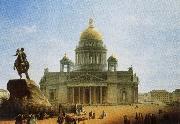 |
nikolay gogol
|
|
With the works of the Russian author Nikolai Gogol (1809-1852) the period of Russian imitation of Western literature ended. He found inspiration in native materials and combined realistic detail with grotesque and otherworldly elements. |
|
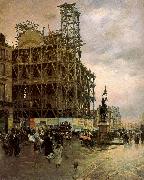 |
Nittis, Giuseppe de
|
|
Italian, 1846-84
Italian painter, pastellist and printmaker. Throughout his career he was committed to a plein-air aesthetic and was particularly interested in rendering varying light effects, a concern that brought him into contact with the Impressionists. He was also acquainted with the members of the Macchiaioli, for whom his work was influential. In addition to oils, he experimented with printmaking and made innovative use of pastels. Practising a restrained, and therefore 'acceptable', form of Impressionism, he achieved great success in his lifetime, |
|
 |
Norbert Goeneutte
|
|
1854-1894
French
French painter and engraver. In 1871, after working briefly as a lawyer's clerk, he entered the studio of Isidore Pils at the Ecole des Beaux-Arts. When Pils died in 1875 Henri Lehmann took over the studio and Goeneutte left, moving to Montmartre. There he met Auguste Renoir, for whom he often modelled, and Marcellin Desboutin, who inspired his interest in engraving, etching and drypoint. Although Goeneutte was associated with Manet, Degas and Renoir, and his work was influenced by them, for instance in the informality of his compositions, he never exhibited with the Impressionist group, preferring instead the official Salons. Every year from 1876 he exhibited several works in the Paris Salon, such as Boulevard de Clichy under Snow (1876; London, Tate). He visited London in 1880, Rotterdam in 1887 and Venice in 1890. |
|
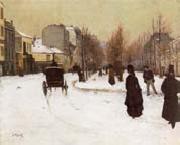 |
Norbert Goeneutte
|
|
French Painter, 1854-1894.French painter and engraver. In 1871, after working briefly as a lawyers clerk, he entered the studio of Isidore Pils at the Ecole des Beaux-Arts. When Pils died in 1875 Henri Lehmann took over the studio and Goeneutte left, moving to Montmartre. There he met Auguste Renoir, for whom he often modelled, and Marcellin Desboutin, who inspired his interest in engraving, etching and drypoint. Although Goeneutte was associated with Manet, Degas and Renoir, and his work was influenced by them, for instance in the informality of his compositions, he never exhibited with the Impressionist group, preferring instead the official Salons. Every year from 1876 he exhibited several works in the Paris Salon, such as Boulevard de Clichy under Snow (1876; London, Tate). He visited London in 1880, Rotterdam in 1887 and Venice in 1890. |
|
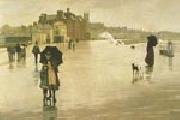 |
Norman Garstin
|
|
(28 August 1847 ?C 22 June 1926) was an Irish artist associated with the Newlyn School of painters.
He was born in Caherconlish, Co. Limerick, Ireland, and was involved in various professions such as journalism and gold mining in South Africa. In 1885 he befriended members of the Newlyn School and settled there a year later, moving to nearby Penzance in 1890.
The Rain it Raineth Every Day 1889His work consisted primarily of small oil panels in the plein air style, something he had picked up from the French Impressionists such as Edouard Manet and Edgar Degas. |
|
|
|
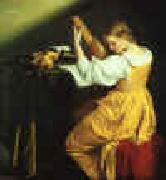 |
Orazio Gentileschi
|
|
1563-1639 Italian Orazio Gentileschi Galleries Tuscan painter, b. Pisa. His real surname was Lomi, but he adopted his uncle name. He studied in Rome, where he was associated with Agostino Tassi in the decoration of palace interiors. Influenced by Caravaggio, Gentileschi developed a more softly luminous light and a cooler, more lyrical style. He also painted frescoes in Santa Maria Maggiore and in the Lateran. After spending several years in Genoa and in France, he settled in England (1626) at the invitation of Charles I. Gentileschi principal works include The Annunciation (San Siro, Genoa); Flight into Egypt (Louvre); Sibyl (Hampton Court, England); and Moses Saved from the Waters (Prado). He also painted numerous portraits. Artemesia Gentileschi was his daughter. |
|
|
|
 |
Pagani, Gregorio
|
|
Italian, 1558-1605
Italian painter. He trained in the studio of the Late Mannerist Maso da San Friano, but then studied with the more progressive Santi di Tito. There he became friends with Ludovico Cigoli: the two artists, who desired to renew the art of painting, studied from nature and developed an interest in Venetian and Emilian art. Pagani was deeply influenced by Correggio. His earliest surviving works include the frescoes of the Confirmation of the Rule of St Dominic (c. 1580; Florence, S Maria Novella, Chiostro Grande) and the Meeting between SS Dominic and Francis (Florence, Convento dei Cappuccini di Monturghi). In 1592 he painted the Virgin and Saints (St Petersburg, Hermitage), a work that already reveals his interest in Correggio. In the same year he painted a Finding of the True Cross (untraced), a daring composition that is preserved in preparatory drawings. A number of works from the 1590s survive and show Pagani's interest in Emilian art; the Crucifixion and Saints (1595; Florence, S Bartolomeo in Pozzo) and the Virgin and Child with SS Michael the Archangel and Benedict (1595; Florence, S Michele Arcangelo Le Ville). At the turn of the century Pagani was increasingly associated with those Florentine artists who wished to develop a new narrative clarity and directness. His pictures (e.g. Pyramus and Thisbe; Florence, Uffizi) show figures carefully posed with varied expressions and gestures. In the early 17th century Pagani became yet more attracted by naturalism, as in the St Lawrence (1600) in the basilica of the Madonna delle Grazie at San Giovanni, Valdarno. Through his friendship with Bartolomeo Carducho he was influenced by Spanish art, as is evident in the Adoration of the Magi |
|
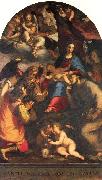 |
Paggi, Giovanni Battista
|
|
Italian Baroque Era Painter, 1554-1627
.Italian painter and theorist. As the son of a newly inscribed nobleman, he received a Renaissance gentleman's education, but as an artist he was it seems self-taught, despite the encouragement of Luca Cambiaso. The gentleman who then set up as a painter was obliged to give his work to patrons, sometimes expecting future remuneration; but when one patron reneged on payment in 1581, Paggi mortally wounded him and was banished from Genoa. He was given protection by Francesco I de' Medici, Grand Duke of Tuscany, and settled in Florence. A fresco of St Catherine Converting Two Criminals (1582), painted for Niccol? Gaddi's family chapel at S Maria Novella and thoroughly Florentine in manner, established Paggi's reputation at the Medici court. He painted ephemeral decorations, portraits (all untraced) and altarpieces for many Florentine churches and for the cathedrals of San Gimignano (c. 1590), Pistoia (1591-3) and Lucca (1597-8), |
|
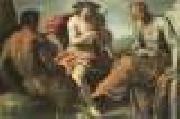 |
PALMA GIOVANE
|
|
Italian Mannerist Painter, ca.1548-1628
Son of Antonio Palma. A greater artist than his father, his vast oeuvre represents the impact of central Italian Mannerism but principally of Jacopo Tintoretto on Venetian painting in the generation after Titian, Tintoretto and Paolo Veronese. He died in his late seventies and was occasionally referred to as 'il vecchio', but since the 17th century he has been known as 'il giovane' to distinguish him from his great uncle. He was virtually self-taught, apart from a presumed acquaintance with his father's workshop. In 1567 he came to the attention of Guidobaldo II della Rovere, Duke of Urbino, who was to support him for four years. A possible knowledge of Federico Barocci's art at the court of Urbino left little trace on his surviving early works. The Duke sent him to Rome for study, where he spent a few months apprenticed to an unknown artist. There his sympathy was with Taddeo Zuccaro and Federico Zuccaro, who influenced the graphic style of the drawing of Matteo da Lecce (1568; New York, Pierpont Morgan Lib.), his first dated work. His Roman sojourn, which lasted until c. 1573-4, made a direct impact on some of his Venetian works and indirectly made him receptive to Tintoretto's style. A tendency in Rome in the 1560s to retreat from the most artificial and decorative aspects of Mannerism in favour of naturalism was also to affect Palma's attitude to style in his mature works |
|
|
|
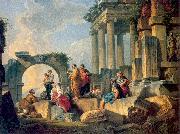 |
Panini, Giovanni Paolo
|
|
Italian Neoclassical Painter, ca.1691-1765
Italian painter, architect and stage designer. He was a highly prolific and versatile painter, best known for his numerous vedute of Rome, many of which focused on the remnants of the city's Classical past. Ceremonies and festivals often feature in his vedute, which thus constitute a lively documentation of contemporary topography, lifestyle and customs. In contrast to Bernardo Bellotto and Gaspar van Wittel, his treatment is picturesque rather than rigorous; he liked to enliven and animate his views by adding numerous figures. He worked exclusively in Rome and by the end of his career was the head of a thriving workshop that included the Frenchman Hubert Robert (in Rome from 1754) and Panini's son Francesco Panini (b 1738). |
|
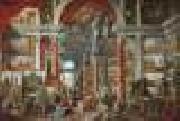 |
PANNINI, Giovanni Paolo
|
|
Italian Neoclassical Painter, ca.1691-1765
was an Italian painter and architect, mainly known as one of the vedutisti or (veduta, or "view painters"). As a young man, Pannini trained in his native town of Piacenza as a stage designer. In 1711, he moved to Rome, where he studied drawing with Benedetto Luti and became famous as a decorator of palaces, including the Villa Patrizi (1718C1725) and the Palazzo de Carolis (1720). As a painter, Pannini is best known for his vistas of Rome, in which he took a particular interest in the city's antiquities. Among his most famous works are the interior of the Pantheon, and his vedute paintings of picture galleries containing views of Rome. Most of his works, specially those of ruins have a substantial fanciful and unreal embellishment characteristic of capriccio themes. In 1719, Pannini was admitted to the Congregazione dei Virtuosi al Pantheon. He taught in Rome at the Accademia di San Luca and the Academie de France, where he influenced Jean-Honore Fragonard. His studio included Hubert Robert and his son Francesco Panini. His style would influence a number of other vedutisti, such as his pupil Antonio Joli, as well as Canaletto and Bernardo Bellotto, |
|
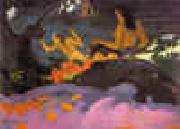 |
Paul Gauguin
|
|
French
1848-1903
Paul Gauguin Art Locations
(born June 7, 1848, Paris, France ?? died May 8, 1903, Atuona, Hiva Oa, Marquesas Islands, French Polynesia) French painter, sculptor, and printmaker. He spent his childhood in Lima (his mother was a Peruvian Creole). From c. 1872 to 1883 he was a successful stockbroker in Paris. He met Camille Pissarro about 1875, and he exhibited several times with the Impressionists. Disillusioned with bourgeois materialism, in 1886 he moved to Pont-Aven, Brittany, where he became the central figure of a group of artists known as the Pont-Aven school. Gauguin coined the term Synthetism to describe his style during this period, referring to the synthesis of his paintings formal elements with the idea or emotion they conveyed. Late in October 1888 Gauguin traveled to Arles, in the south of France, to stay with Vincent van Gogh. The style of the two men work from this period has been classified as Post-Impressionist because it shows an individual, personal development of Impressionism use of colour, brushstroke, and nontraditional subject matter. Increasingly focused on rejecting the materialism of contemporary culture in favour of a more spiritual, unfettered lifestyle, in 1891 he moved to Tahiti. His works became open protests against materialism. He was an influential innovator; Fauvism owed much to his use of colour, and he inspired Pablo Picasso and the development of Cubism.
|
|
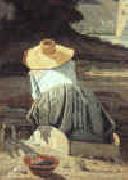 |
Paul-Camille Guigou
|
|
1834-1871
French
Paul Camille Guigou Gallery
French painter. Born into a family of landowners, he became a notary's clerk at Apt in 1851 and then in 1854 at Marseille. He learnt to paint with Camp, a teacher at the school in Apt, and then at Marseille with Emile Loubon (1809-63), director of the local Ecole des Beaux-Arts, who urged him (according to Guigou's biographers) to paint directly from nature. Guigou settled in Marseille in 1854, where he participated regularly in the annual Salon of the Societe Artistique des Bouches-du-Rhene. Guigou painted almost exclusively Proven?al landscapes, which were influenced by the works of the Barbizon painters, who exhibited in Marseille, and by the brownish tones and picturesque figures of Loubon's paintings. The Road to Gineste (1859) and The Washerwoman (1860; both Paris, Mus. d'Orsay) reflect the independent tradition of Proveneal painting during the Second Empire, which was characterized by warm colouring and precise lighting used to separate and distinguish forms. His knowledge of the works of Gustave Courbet, acquired during a visit to Paris in 1859, doubtless increased his liking for broad technique and sincere vision, articulated in a strong and ordered construction of space: for example, The Gorges of the Luberon (c. 1861; Amiens, Mus. Picardie). |
|
|
|
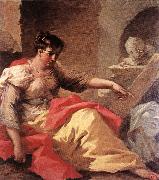 |
PELLEGRINI, Giovanni Antonio
|
|
Italian Rococo Era Painter, 1675-1741
Italian painter. With Sebastiano Ricci and Jacopo Amigoni he was the most important Venetian history painter of the early 18th century. By uniting the High Renaissance style of Paolo Veronese with the Baroque of Pietro da Cortona and Luca Giordano, he created graceful decorations that were particularly successful with the aristocracy of central and northern Europe. He travelled widely, working in Austria, England, the Netherlands, Germany and France. |
|
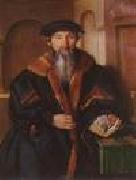 |
PENCZ, Georg
|
|
German Northern Renaissance Painter, ca.1500-1550
German painter, draughtsman and engraver. He arrived in Nuremberg in 1523 and entered Albrecht D?rer's workshop. On 12 January 1525 he was imprisoned with the brothers Barthel Beham and Sebald Beham and charged with disseminating the radical views of Thomas M?ntzer (c. 1490-1525) concerning religion and government. The council banished them from Nuremberg, but, after an appeal and intercession by Graf Albrecht von Mansfeld, Pencz was sent to nearby Windsheim, and on 16 November all three were pardoned, though placed under orders regarding their future behaviour. |
|
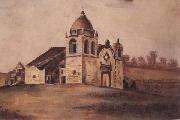 |
Percy Gray
|
|
1869-1952
was an American painter. Gray was born into a San Francisco family endowed with a broad literary and artistic background. He studied under Arthur Frank Mathews at the San Francisco School of Design and later under William Merritt Chase. While he had some early Impressionistic tendencies, his primary expression was under the Tonalism Mathews had brought back from Paris. He is known for his extraction of beauty from the Northern California landscape. Alexander Gray, Percy's father, was born in England, but found his way to a successful insurance business in San Francisco. As the byproduct of a childhood illness, Percy realized he had talents in art. From 1886 to 1888 he attended the California School of Design, then led by Mathews. From there he went on to become a newspaper illustrator, obtaining a job with the New York Journal. In New York he also studied at the Art Students League. He was dispatched from New York to cover the 1906 San Francisco earthquake, but decided to remain in his native city where he would then take up his painting career. Gray's first pieces, headland seascapes, were exhibited in 1907; soon thereafter he addressed in watercolor eucalyptus groves and fields of California wildflowers. These subjects would become signatures of his work. Originally Gray's works were oils; however, he eventually developed an allergy to oil paints, and therefore switched to using watercolors as his primary medium. [1] From early on the critics marvelled at his ability to infuse realistic depictions of nature with a mystical and poetic quality. He was clearly applying the precepts of his mentor William Merritt Chase in exaggeration of light and color. From 1912 to 1923 Gray lived in Burlingame, California about twenty miles south of San Francisco, while keeping his studio in the city itself. At the 1915 Panama-Pacific International Exposition he won a bronze medal for his watercolor Out of the Desert, Oregon. Having been a bachelor for 53 years, Gray surprised his friends by marrying. He and his bride moved to the Bonificio Adobe in Monterey, where seascapes and cypress dominated his later works. |
|
|
|
|
|
|
|
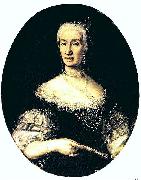 |
Pier Francesco Guala
|
|
(15 September 1698 - 27 February 1757), also known as Pierfrancesco and Pietro Francesco, was an eighteenth-century Italian painter active for the most part in the region of his place of birth, Casale Monferrato.
Guala was the seventh of eight siblings of whom only he and a sister survived infancy. His mother died when he was five and he was brought up by his father, Lorenzo, who himself was a painter and perhaps related to the architect Sebastiano Guala.
Pier Francesco Guala died in Milan on 27 February 1757.
|
|
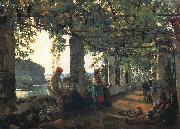 |
Pier Leone Ghezzi
|
|
(Rome, 28 June 1674 - Rome, 6 March 1755) was an Italian Rococo painter and caricaturist active in Rome.
Caricature of composer Antonio Vivaldi by Pier Leone GhezziGhezzi was born in Rome. His father, Giuseppe Ghezzi, (1634-1721), also trained Antonio Amorosi, and was a secretary to the Roman Accademia di San Luca. Pier Leone himself joined the Academy in 1705 and he executed a painting, the Allegory of Gratitude, to be donated to the institution, as was customary.
He was the godson of Carlo Maratta. Pier Leone is known for his frescoes in the Villa Falconieri of Frascati.
His pen and gouache caricatures are much freer in emotion than his state portraiture, and often depict named individuals or professions in satirical fashion.
|
|
|
|
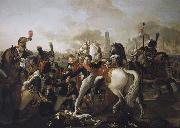 |
Pierre Gautherot
|
|
painted Napoleon Ier, blesse au pied devant Ratisbonne, est soigne par le chirurgien Yvan, 23 avril 1809 |
|
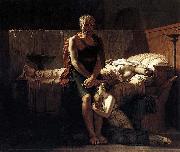 |
Pierre-Narcisse Guerin
|
|
(13 May 1774 - 6 July 1833) was a French painter.
Guerin was born in Paris.
A pupil of Jean-Baptiste Regnault, he carried off one of the three grands prix offered in 1796, in consequence of the competition not having taken place since 1793. In 1799, his painting Marcus Sextus (Louvre) was exhibited at the Salon and excited wild enthusiasm. Part of this was due to the subject - a victim of Sulla's proscription returning to Rome to find his wife dead and his house in mourning - in which an allusion was found to the turmoil of the French Revolution.
Guerin on this occasion was publicly crowned by the president of the Institute, and went to Rome to study under Joseph-Benoît Suvee. In 1800, unable to remain in Rome on account of his health, he went to Naples, where he painted the Grave of Amyntas. In 1802 Guerin produced Phaedra and Hippolytus (Louvre); in 1810, after his return to Paris, he again achieved a great success with Andromache and Pyrrhus (Louvre); and in the same year also exhibited Cephalus and Aurora (Louvre) and Bonaparte and the Rebels of Cairo (Versailles). These paintings suited the popular taste of the First Empire, being highly melodramatic and pompously dignified.
The Restoration brought to Guerin fresh honours; he had received from the first consul in 1803 the cross of the Legion of Honour, and in 1815 Louis XVIII named to the Academie des Beaux-Arts. His style changed to accord with popular taste. In Aeneas Relating to Dido the Disasters of Troy (Louvre), Guerin adopted a more sensuous, picturesque style.
Guerin was commissioned to paint for the Madeleine a scene from the history of St Louis, but his health prevented him from accomplishing what he had begun, and in 1822 he accepted the post of director of the French Academy in Rome, which in 1816 he had refused. On returning to Paris in 1828, Guerin, who had previously been made chevalier of the order of St. Michel, was ennobled. He now attempted to complete Pyrrhus and Priam, a work which he had begun at Rome, but in vain; his health had finally broken down, and in the hope of improvement he returned to Italy with Horace Vernet. Shortly after his arrival at Rome Baron Guerin died, on the 6th of July 1833, and was buried in the church of La Trinite de Monti by the side of Claude Lorrain.
|
|
 |
Pieter de Grebber
|
|
1600-1653
Dutch
Pieter de Grebber Gallery
Grebber was the son of Frans Pietersz de Grebber (1573?C1643), a painter and embroiderer in Haarlem, and would have been taught painting by his father and by Hendrick Goltzius. He was descended from a Catholic and artistic family (2 of his brothers, and his sister Maria, the mother-in-law of Gabriel Metsu, were known as painters). He was friendly with the priest and musicologist Jan Albertszoon Ban, and had a poem set to music by the Haarlem composer Cornelis Padbru??.
In 1618, father and son went to Antwerp and negotiated with Peter Paul Rubens over the sale of his painting "Daniel in the lions pit". It was then handed - via the English ambassador in the Republic, Sir Dudley Carleton - to king Charles I. Pieter got important commissions not only in Haarlem, but also from the stadholder Frederik Hendrik. As such, he worked with on the decoration of the Huis Honselaarsdijk in Naaldwijk and at the Paleis Noordeinde in Huis ten Bosch in the Hague. He painted altar pieces for churches in Flanders and hidden Catholic churches in the Republic. He may also have worked for Danish clients.
|
|
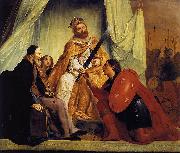 |
Pieter de Grebber
|
|
(c. 1600, Haarlem - 1652/3, Haarlem) was a Dutch Golden Age painter.
De Grebber was the oldest son of Frans Pietersz de Grebber (1573 - 1643), a painter and embroiderer in Haarlem, and the brother of the painters Maria and Albert. He learned to paint from his father and from Hendrick Goltzius. He was descended from a Catholic and artistic family and his sister Maria later became the mother-in-law of Gabriel Metsu. He was a friend of the priest and musicologist Jan Albertszoon Ban, and had a poem set to music by the Haarlem composer Cornelis Padbrue. In 1632 he became a member of the Haarlem Guild of St. Luke, but he had already been active as a painter for 10 years. His pupils were Gerbrand Ban, Nicolaes Pietersz Berchem, Egbert van Heemskerck, and Dirck Helmbreeker.
In 1618, father and son went to Antwerp and negotiated with Peter Paul Rubens over the sale of his painting "Daniel in the lions pit". It was then handed - via the English ambassador in the Republic, Sir Dudley Carleton - to king Charles I. Pieter got important commissions not only in Haarlem, but also from the stadholder Frederik Hendrik. As such, he worked on the decoration of the Huis Honselaarsdijk in Naaldwijk and at the Paleis Noordeinde in Huis ten Bosch in the Hague. He painted altar pieces for churches in Flanders and hidden Catholic churches in the Republic. He may also have worked for Danish clients.
Pieter remained single and lived from 1634 until his death at the Haarlem Beguinage.
|
|
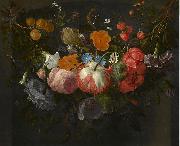 |
Pieter Gallis
|
|
(1633, Enkhuizen - 1697, Hoorn), was a Dutch Golden Age painter.
According to Houbraken, he painted as a hobby, since he earned his living as the director of the local pawn shop (Bank van Lening).He specialized in landscapes, flowers, fruit and other forms of still life. He was a very friendly man, especially to artists and art collectors.
He was active in Enkhuizen (and perhaps Amsterdam), in Purmerend from 1679-1683, and in Hoorn from 1683 until his death. |
|
|

